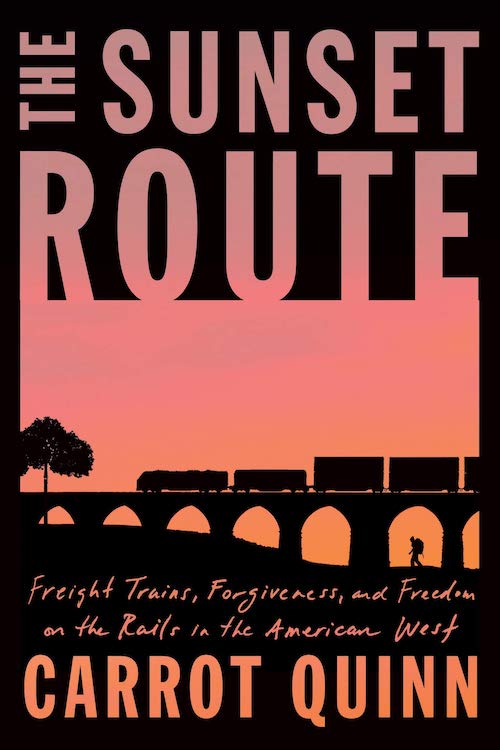
THE UNITED STATES has forgotten the hobo. We recognize the problem of homelessness, but the rootless rambler who steals rides on freight trains seems a relic of a long gone past. Even the word itself, hobo, is outdated. The same goes for the word tramp, which, if used at all tends to be for slut-shaming purposes. The term bum remains, but it, too, is derogatory, perhaps only acceptable as a verb, as in, “Can I bum a smoke?”
But one cannot truly understand this country without considering the dreams and habits of its underclasses, and there is plenty of material to probe, a whole genre of hobo letters: poems, songs, stories, essays, articles, novels, memoirs, and plays, even a newspaper called Hobo News.
“The hobo who reads sooner or later tries his hand at writing,” Nels Anderson wrote in The Hobo: The Sociology of the Homeless Man, an innovative ethnographic study published in 1923. “A surprisingly large number of them eventually realize their ambition to get into print.”
As a graduate student at the University of Chicago, Anderson spent a year among 400 people at a Chicago “hobohemia” (homeless camp). He recorded stories, cataloged slang, described customs, and classified social strata. Anderson wanted to understand why people (mostly men) ended up on the streets, and why some of them, even if they found shelter, couldn’t seem to stay put. Reasons for the latter fell into several categories, including seeking seasonal work, evading discrimination, and having wanderlust.
What was clear even in those days was that not every hobo was desperate. For a good many, their motivation was to break away from society’s shackles, to light out, like fearless poets, into the great unknown. We might call them free spirits now: idealistic, dreamy travelers who scribbled in their notebooks or doodled on coal cars with chalk. As Walt Whitman wrote, “I tramp a perpetual journey […] My signs are a rain-proof coat, good shoes, and a staff cut from the woods.”
¤
In her new memoir, The Sunset Route:Freight Trains, Forgiveness, and Freedom on the Rails in the American West, Carrot Quinn revives and updates this overlooked tramping tradition — a tradition that first deserves some examination.
If train riders have always leaned into nonconformity, theirs was far from a monolithic culture. Strictly speaking, hobos were those travelers actively looking for work. Tramps scorned work, favoring adventure and thrills. And those suffering from addiction were called bums. There were dozens of subcategories as well, each with colorful names: “stew bums,” “pillingers,” “floppers,” “panhandlers,” “moochers,” “mission stiffs,” “bindlestiffs,” “pokey stiffs,” “fuzzy tails,” “ding bats,” “gay cats,” and “jungle buzzards.”
Sometimes it got dark. A “jocker,” for example, was a train rider “who exploits boys” either for sex or to “steal or beg for him or both.” Those exploited boys were called “punks.” Potential punks were called “gonsils.”
Perhaps the most feared by society were the “yeggs,” serial train-hopping thieves; or, as one of Anderson’s sources put it: “roving desperados.” It could be a brutal, cutthroat life. But it could also be a liberating life. From the outside, that can be hard to understand.
Anderson’s was far from the first nonfiction book on the subject. In 1899, the hobo-turned-writer Josiah Flynt published Tramping with Tramps, a groundbreaking volume of nonfiction sketches from his travels. Eight years later, in 1907, Flynt died of pneumonia, the same year Jack London dedicated his memoir to him, a book about his own hoboing days called The Road.
One of the most celebrated contributions — though rarely remembered now — was The Autobiography of a Super-Tramp (1908) by W. H. Davies, a British poet who tramped across the United States during “the Gay Nineties.” The first edition of Super-Tramp came packaged with a gushing preface by none other than George Bernard Shaw. “Another effect of this book on me,” Shaw wrote, “is to make me realise what a slave of convention I have been all my life.”
Other notable works in the early 20th century include Jim Tully’s Beggars of Life (1924) and Jack Black’s 1926 memoir, You Can’t Win. The latter is a hair-raising tale, and my personal favorite, by a former “respected member of the ‘yegg’ brotherhood.” Black takes the reader from jewel heists to jailhouses to jailbreaks to opium dens to — well, you get the point. The anarchist Dr. Ben L. Reitman, Emma Goldman’s longtime lover and a physician to down-and-outs, sneakily penned Boxcar Bertha in 1937, a novel disguised as a memoir by a fictitious woman by the same name. Woody Guthrie published an autobiographical hobo novel, Bound for Glory, in 1943.
Since that time, every once in a while, some train rider publishes travel reflections or a how-to manual, adding to the ever-growing stack. The most notable, since the genre’s peak in the 1920s, are Ted Conover’s Rolling Nowhere (1984) and William T. Vollmann’s Riding Toward Everywhere (2008). So many great hobo books, such a rich tradition, and yet they struggle to stay in print.
Over the years, as automobiles proliferated, creating a new mode for traveling relatively cheaply, hobos reduced in number, and those who stuck around moved yet further to the margins. The freight train rider was recognized less and less as a category of contemporary American. The category was co-opted and infantilized in Gertrude Chandler Warner’s Boxcar Children book series (1924–) and in Disney’s 1955 animated feature Lady and the Tramp. By the time Bound for Glory was adapted for the screen in 1976, hobo culture had entered nostalgic Americana territory for good. But that didn’t mean hobos didn’t still exist.
The stories in hobo memoirs are sometimes wonderful and often gripping. The best of them satisfy an itch for a romantic reader looking to shake the malaise of modern life, the responsibilities of work and home. The authors of these books may be poor, but they are seldom victims. On the contrary, they brazenly and cleverly find ways to take charge of their lives, sometimes conning their “betters” or otherwise living off handouts and scraps. They simply opt out of capitalism, refuse to play the game. And still they get to see all the glorious sights in this country, only they do it from a rumbling, rolling freight train.
¤
I love hobo stories, not only because they open a window into a little-known United States, but because I used to ride trains myself. I got on my first train in 2003 and my last in 2010. It was an occasional thing — summertime adventures, travels to protests or gatherings or distant friends. Once, on a lark, I caught a ride to Vancouver and later rode on a fast double stack 1,500 miles to Winnipeg, just to see a little more of Canada. Another time, seven friends and I, each with a bike, caught an empty boxcar across central Oklahoma. Those memories are dear to me because it felt like anything could happen. Money was no longer an excuse to miss out.
For those with wanderlust in the anarcho-punk scene — that is, the wing of punk rock culture that takes seriously song lyrics critiquing hierarchical systems, such as capitalism and the state, and instead advocates autonomy, mutual aid, and a do-it-yourself approach to just about everything — it’s a rite of passage to ride the rails at least once. Some of these travelers spend years without a fixed residence, squatting empty shacks or warehouses, crashing on friends’ couches, camping in the remnants of old hobo “jungles” near train yards. When they aren’t on the road, they tend to live communally in flophouses (or “punk houses”). They challenge middle-class values regarding property, hygiene, and sex.
Punk is a network and a refuge all at once. Like the tramps of yesteryear, punks hang out with their own kind. They self-marginalize. They have their own lingo and their own uniform — flannel shirts, band T-shirts, double-knee Carhartt bibs or work pants, lots of black — and their folklore overlaps with hobos. Or more accurately put, punks are keeping hobo customs alive. They inherited the culture. An uninformed cynic might assume punk train riders are nothing like hobos from the past. But that cynic would be wrong. Overtly political and industrious punks are reminiscent of the famed Wobblies.
A century ago, many members of the Industrial Workers of the World, a.k.a. the Wobblies, were self-described hobos. As radical anarcho-syndicalists, their motto was “One Big Union,” and their members often traveled by rail to rallies and strikes, soapboxing and distributing propaganda, organizing workers from coast to coast. The Wobblies wrote leaflets, broadsheets, pamphlets, and articles in radical newspapers, such as Industrial Solidarity and Industrial Worker.
Traveling punks, like their counterparts in history, are, of course, not all the same. At the other end of the spectrum, you’ll find nihilistic types, sometimes called “oogles” or “gutter punks” (although the latter are typically less mobile). The worst of them are bigots, often abusive, and embattled with various addictions. These terms, like most terms, are imprecise and messy, and they are certainly stereotypes. People from this world might denounce me as judgmental for painting them as such. I write this, though, not to dehumanize or pigeonhole anyone but to contrast them with the more conscientious punk train riders who are generally more sober, more involved in activism, and more likely to write and publish radical texts.
Other than self-published zines, blogs, and the anonymously written book Evasion (published by the anarchist collective CrimethInc.), this aspect of hobo culture, a fringe of a fringe, has been missing from the hobo literary canon that I’ve already discussed. But if hobo literature were to ever transcend its status as a niche cultural artifact, it would need an update that includes a contemporary punk perspective and, perhaps most importantly, a woman’s perspective. Thankfully, now we have both in The Sunset Route. Its author, Carrot Quinn, is a queer woman from Alaska, who escaped an abusive childhood and discovered meaning and healing out on the rails.
The Sunset Route, named after the legendary train route from New Orleans to California, is a coming-of-age tale like none that I’ve read. It’s the Boxcar Bertha of our time. But unlike that earlier book, Quinn’s story is true. It goes beyond adventure stories — although plenty are found in its pages — and injects much-needed pathos into the genre, ensuring, I hope, the book’s wider appeal.
Few hobos are born into this life. They come from somewhere. In typical hobo narratives, the author’s upbringing is either left out or glossed over. Street cred can diminish if one comes from a middle-class background, as many hobos do. Quinn, though, comes from abject poverty. Her mother suffered from schizophrenia, chain-smoking all day in their dingy Anchorage, Alaska, apartment, the smoke staining the curtains yellow. Her mother often forgot to eat or feed her two young children. Occasionally she beat them and ranted to them in Jesus-inspired gibberish, leaving them to their own devices. They tried their best to dodge her blows. They survived for years off ketchup packets and dumpstered or stolen food. They dreamed of getting away for good, and they managed to do it.
“My hunger was my constant companion,” Quinn writes of those early years, when she found escape in the public library, in books, in anything that distracted her from the terror back home. “The wind moaned, knocking itself against the boughs of the trees, wailing against every solid object. Unlike me, I realized, the wind was free. It could cut loose its sorrow against the wide, empty night.”
The prose is beautiful like this throughout. It’s also funny and full of wonder and power and charm. Rather than frontloading her origin story, as most do, Quinn braids scenes of childhood with scenes of discovering punk and traveling and all the freedom that they offered. We begin on a train but soon find the narrator moving through all her haunts: the protests and punk houses and all the rest. In 2005, a few years into her new radical life, Quinn meets a fellow traveler who calls herself Finch and gives her a copy of Annie Dillard’s Pilgrim at Tinker Creek. Quinn carries the battered book around like a talisman. “Annie is my only friend,” she admits at one of her lowest points, a thought she has while riding on a mail train on the Highline from Portland to Chicago, trying to outrun, yet again, her perennial loneliness.
Quinn’s are some of the best passages I’ve seen about riding the rails. “Train riding is a thrift store puzzle that’s missing half the pieces,” she writes. “You don’t always know where you’re going or how you’re going to end up there, but you don’t really care, either.”
We get to see it all: hiding from the bulls (railroad cops); landing in jail for trespassing and protesting; playing music and making zines; hustling for money by lending one’s body for pharmaceutical drug trials and sex work, trimming weed, and selling stolen goods on eBay; finding sustenance from dumpstered bagels and Food Not Bombs; living through love, loss, rejection, grief, and hard-won healing; and, finally, forgiving, at long last, her mother, a victim in her own right of a horrendous mental illness.
In an Instagram post promoting the book, Quinn calls the book “a treatise on the power of forgiveness,” one that “totally romanticizes early 2000s punk culture.” That’s the book in a nutshell, but it’s truly so much more. Anyone can tell you how cool it is to ride trains, but Quinn shows you what it’s like. She renders some of the pivotal moments when others showed her how to “cut loose”: a “worldly” older cousin who takes her to Portland, Oregon, after high school and on the drive breaks down our ugly history while riffing off Howard Zinn’s A People’s History of the United States; a friend called Willow who shows Quinn how to wear nice clothes to shoplift (“scamouflage,” we used to call it) and later schools her on how it’s really white privilege that’s allowing them to get away with petty crime. “People only see what they’re expecting to see,” she says. “It’s the same with freight trains.”
Quinn reckons with her privileges as she explores her trauma. It’s the sort of vulnerability you don’t see much in the hobo genre and, in my view, a welcome addition. Our country — our world — is full of contradictions, and Quinn is here to face that truth. As she romps around the American West, taking note of the abundant cowboy hats, she admits, “The fantasy of colonization is strong in the rural West.” She considers her grandparents “homesteading” in western Colorado. “As white people of North America, colonization is our only remembered connection to the earth. How fucked up and sad is that?”
In recent years, Quinn prefers long hikes to noisy, grimy trains. She wrote her debut book, Thru-Hiking Will Break Your Heart, about the Pacific Crest Trail in 2013. If she’s moved past the “decadent poverty” of her train-hopping days, she doesn’t judge her younger self or anyone else for taking part in that scene. It was a time of self-discovery, of rejecting the raw deal that the universe gave her and so many others. She became a hobo because it promised her a better way to live, to experience, to see.
What compares to the vantage of a train thundering across an expanse of open country? Nothing, that’s what.
¤







